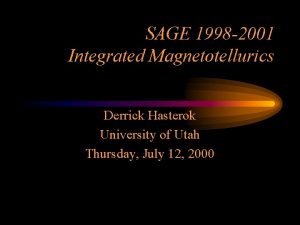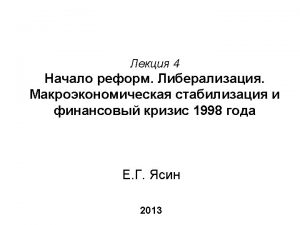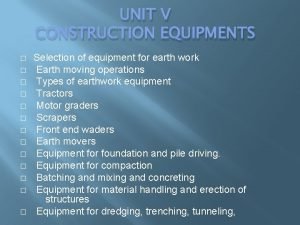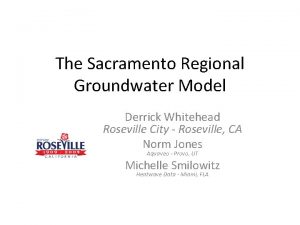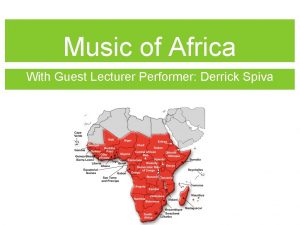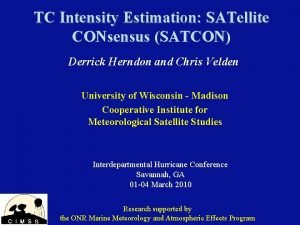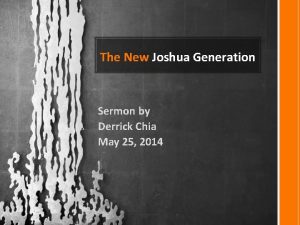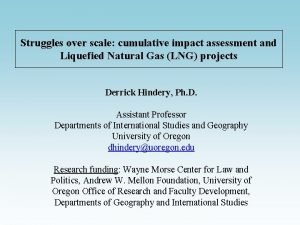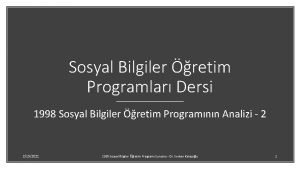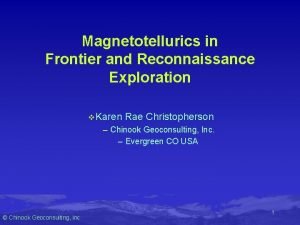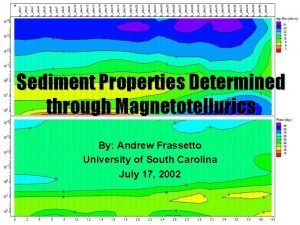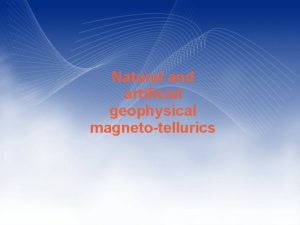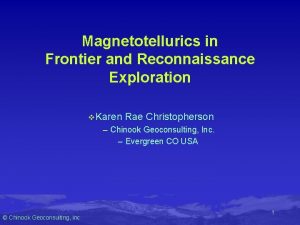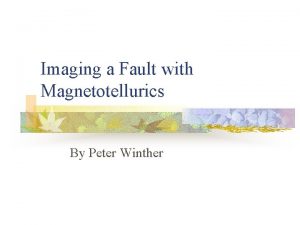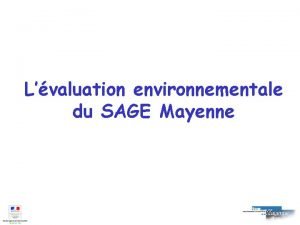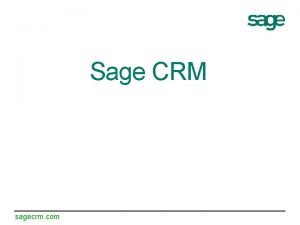SAGE 1998 2001 Integrated Magnetotellurics Derrick Hasterok University
















- Slides: 16

SAGE 1998 -2001 Integrated Magnetotellurics Derrick Hasterok University of Utah Thursday, July 12, 2000

Topics for Discussion • Mid-crustal conductor (MCC) – – physical properties possible causes implications on reology nature of MCC from integrated 1998 to 2001 SAGE MT data • Results from 2000 work • Integrated results 1998 -2001 • Deep electrical structure beneath the Santo Domingo and Española basins

Mid-Crustal Conductor • What is the MCC? – A widespread (world-wide? ) conductive layer at great depth – May correspond to the brittle-ductile transition zone or an isotherm (350º - 650º C) – May correspond to similar depth as seismic reflectors

Physical Properties and Depths • Resistivities of MCC are lower under active tectonic regions and occur at shallower depths • Most dry rocks expected at great depth have high resistivities >103 -m

Mid-Crustal Conductor • Possible causes – Magma (probably not cause in Rio Grande rift) – Hot mineralized (saline) water (perhaps) – Graphite, Ilmenite, Pyhrrotite, Pyrite and other conductive solid phase minerals • Must be interconnected. How do you get interconnectivity? – Dihedral angle (What is this? ) • What is the porosity necessary?

Interconnecting Fluid (porosity) • Porosity is determined by Archie’s Law: rrock = a rmat f-m – r = resistivity – f = porosity – m = cementation factor • approximation – m = 1 for a thin film – f = 1. 4 rmat/rrock • Porosity of fluid (rrock = 10 ) – magma • rmat = 0. 5 -m • f = 7% – hot saline • rmat = 0. 01 -m • f = 0. 14 % – graphite • rmat = 0. 5 -m • f = 1. 4 x 10 -5 %

Interconnecting Fluid (dihedral angle) • What is the dihedral angle ( )? – the angle of intersection between the rock grains and fluid contacts – governed by type of fluid and solids – for interconnectivity 60 0 (for most fluids)

Water at great depths How does the water get down there? • Meteoric – ground water circulation • Metamorphic dehydration • Sub-crustal – mantle and magma degassing

Water at great depth (cont. ) More discussion on water: • Water depth corresponds to brittle-ductile transition zone – can move laterally very rapidly – pore geometry prevents rapid assent of water • Water must be in P-T equilibrium with retrograde metamorphism

Graphite • Where does the graphite come from? – The graphite comes from reduction of CO 2 – Could be result of P-T conditions (i. e. MCC is result of P-T isotherm) • Where does the CO 2 originate? – CO 2 is present in magmas and the mantle and produced during some metamorphic reactions

1998 and 2000 Integrated Model 2 -D Inversion of 1998 and 2000 MT Soundings (TE and TM) Depth (km) 0 15 35 N 45 W Distance (km) S 45 E

2 D Inversions of 98 -01 MT Data • Stations differentially rotated (polar plots at long period) – 1998 - N 45 E – 1999 - 2001 - N 50 W – 2000 - N 60 E • Rotations roughly correspond to gravity strike on west side of line. • Station s 0102 not included because of possible 3 D effects (i. e. Cerrillos Hills) • Station s 9902 not used because of bad data

2 D Inversions 1998 to 2001 data 2000 soundings (rotation = N 60 E) Depth (km) 0 15 35 N 60 W Distance (km) N 60 E RMS = 1. 4462

2 D Inversions 1998 to 2001 data 1999 and 2001 soundings (rotation = N 50 W) Depth (km) 0 15 35 N 50 E Distance (km) N 50 W RMS = 3. 3235

2 D Inversions 1998 to 2001 data 1998 soundings (rotation = N 45 E) Depth (km) 0 15 35 N 45 W Distance (km) N 45 E RMS = 3. 0007

Conclusions • SAGE 1998 to 2001 MT data – Mid-Crustal Conductor • Depth of MCC decreases from west to east • Resistivity of MCC increases from west to east • Cause – hot saline water? – graphite? – not melt – Move off active rift on east side of profile
 Derrick hasterok
Derrick hasterok Torp y sage 1998
Torp y sage 1998 1993 1994 1995
1993 1994 1995 Guy derrick crane
Guy derrick crane Alton brown turkey derrick
Alton brown turkey derrick Dr derrick butler
Dr derrick butler Hitchcock isd
Hitchcock isd Derrick whitehead
Derrick whitehead Youtube derrick 1973
Youtube derrick 1973 Derrick swistak
Derrick swistak Derrick herndon
Derrick herndon Derrick kearney
Derrick kearney Derrick fulton
Derrick fulton Chia serm
Chia serm Derrick hindery
Derrick hindery University management system project
University management system project 1998 sosyal bilgiler öğretim programı
1998 sosyal bilgiler öğretim programı
